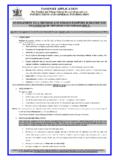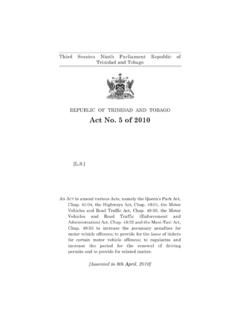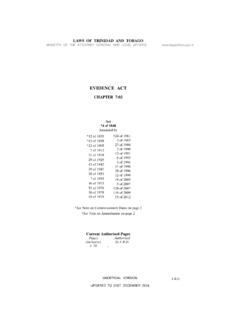Transcription of Subregional Office for the Caribbean ISSUE BRIEF
1 1 Praedial Larceny in the CaribbeanISSUE BRIEF Praedial larceny - the theft of agriculture produce - is widely acknowledged in the region as a practice that is negatively impacting the development of the agricultural sector. Agricultural producers (crop, livestock, marine fishers and aquaculturists) suffer heavy losses and are hesitant to invest and expand their enterprise. Illegal fishing or piracy of fishery resources in the Exclusive Economic Zones of respective member states is also considered praedial larceny and legislation in several member states also extends the definition of the offence to include the theft of agricultural equipment, agriculture inputs and secondary products such as feed and and programmes to combat praedial larceny have become an integral consideration in how agriculture producers, processors and distributors function in the region in an effort to secure their on-farm investments, and in how policy makers build strategies to secure the economic gains from public investment in the sector.
2 Given the importance of this constraint, the Food and Agriculture Organization (FAO) conducted a comprehensive study, An Analysis of the State of Praedial Larceny in Member States of CARICOM in collaboration with the Caribbean Disaster Emergency Management Agency (CDEMA) under the umbrella of the Agricultural Sector Disaster Risk Management Committee (ASSC/TMAC).A summary of the results is presented here. Subregional Office for the CaribbeanKEY FACTS#3 July 2013 XPraedial larceny is the most extensive among all crimes committed in the subregion in terms of the number of persons and families affected. X98% of all producers surveyed have experienced loss of produce from theft. XMore than 90% of producers regionally agree that it is the single greatest disincentive to investment in the sector. XConservative estimates are that 18% of the value of farm output regionally is taken by thieves, resulting in the loss of millions of United States dollars annually.
3 XLack of reporting due to frustration with inaction by authorities means only 45% of incidences are reported to the police regionally. XData suggests that just over 35% of produce stolen at the regional level is used for household food and other needs in the home. XRegionally the largest share of the produce stolen (27%) is disposed of in the higgler/huckster trade which is dominated by rural women, most of whom are single, vulnerable household heads and with no other source of of pineapples or the harvest of a freshwater fish pond with a determination among the thieves that poses serious dangers to farm families and farm workers. Some aquaculture farmers have abandoned their entire enterprise due to heavy losses and the high cost paid for security. Offenders operate in a complex social and economic environment encompassing varied groups of individuals who have developed livelihoods and businesses from the stealing of agriculture produce , equipment and materials.
4 Each group has developed its own dynamics in a distribution chain where the crime enters undetected into the normal processes of legitimate industry of especially domestic fresh food distribution. Conservative estimates are that 18% of the value of farm output regionally is taken by thieves, resulting in the loss of millions of United States dollars annually. This does not account for future loss to agriculture production and productivity when farmers leave the sector or when high quality genetic breeds of livestock and crop varieties are stolen from breeding stations and agriculture research facilities and sold as food. Nor does it take into consideration the likely consequences Extent, nature and magnitude of praedial larcenyPraedial larceny is the most extensive among all crimes committed in the subregion in terms of the number of persons and families affected. On average 82% of farmers and fishers affected are commercial or semi-commercial producers between the ages of 45 and 50 years.
5 Poor and vulnerable farming populations are not spared. 98% of all producers surveyed have experienced loss of produce from theft - more than 332 000 fisher folk families, and well over 1 000 000 crops and livestock farm families. The crime also has potentially high, though undetermined, social costs to welfare in farming communities, livelihoods and household food security. More than 90% of producers regionally agree that it is the single greatest disincentive to investment in the sector. Praedial larceny is no longer viewed as a petty crime but one of the most pervasive and entrenched crimes affecting business and livelihoods - the only crime at regional level that consistently trends upwards. Praedial larceny has moved from the theft of small amounts to large amounts of produce involving in some instances truckloads of bananas, an entire for public health and subsequent industry fallout should tainted, uncertified produce gain entry into the domestic food of praedial larceny Several factors encourage the growing spread of praedial larceny.
6 With the development of agri-business chains and diversity of livelihood activities from agriculture, fresh produce has become another input in the high cost of business. There is often an imbalance in the daily demand and supply of fresh food and the buyer often has little or no interest in the legitimacy of the source of the produce . Maintaining the integrity of the supplier/producer relationship necessitates reliability of supplies, freshness, smaller amounts not requiring storage and an acceptable price. Praedial larceny s most readily identified business feature is the ability of the supplier to combine large volumes, timely delivery and a level of determination to ensure his delivery that does not rule out the use of violence. Unlike other risks in agriculture management, risk management of praedial larceny requires significant inputs from the criminal justice system, traceability systems for proof of ownership under the law, information sharing for deterrence and for capacity building, networking and intelligence gathering on the nature and reduction of the risk.
7 Critical weaknesses and deficiencies in the legislation and the criminal justice system related to praedial larceny include: XWeak sensitivities to the social and economic consequences among the critical players, including the Police and Judiciary, resulting in failure to treat praedial larceny as a serious offence. Fines and penalties awarded under the law have not proven to be a deterrent to the thieves; low priority given to the hearing of praedial larceny cases by the Courts and the ease with which bail is granted to repeat Theft of fish and gear is also considered praedial larceny3offenders undermines efforts to reduce praedial larceny. XUnfamiliarity and underutilization by the Police of relevant legislative acts that can be used for prosecution, including the Trespass Act and the Unlawful Possession Act, which may be applied when the source of the produce is not identified in a timely manner.
8 XLack of reporting due to frustration with inaction by authorities means only 45% of incidences are reported to the police regionally. Thieves are therefore fairly confident they will face limited or no consequences. XInsufficient proof of ownership. Data management for traceability of produce is inefficient at the farm level. Ineffective registration processes do not permit produce to be followed from the source to the consumer and the monitoring of movement of produce within countries is not enforced. XInformation sharing on praedial larceny is absent at the community level, so the data and information are inadequate to provide guidance to the Police on critical areas such as hotspots, preferred subsectors and commodities or to build intelligence on the habits of suspicious or known perpetrators. XFarmer organizations and farmers are not sufficiently vigilant in information sharing and networking and do not adequately support the Receipt Book System including proper record keeping and the reporting of incidences or suspicious activities.
9 Addressing praedial larcenyWhen tackling praedial larceny there are unique sensitivities that must be addressed through a multisectoral and multifaceted approach to ensure appropriate integration of policy issues. Provisions must be made for: XIssues of land tenure and proof of ownership of land and produce under the law XPrograms for alternative livelihoods to manage the perceived relationship between vulnerable and poor households and praedial larceny in rural populations and along rural/urban livelihood chains. XData suggests that just over 35% of produce stolen at the regional level is used for household food and other needs in the home. XPublic education and communication strategies that empower and build resilience in farmers and fisher folks and their organizations at all levels - regional, national and community - in praedial larceny prevention and reduction. XInformation systems that provide clarity in the relationships in the legitimate businesses in the higgler/huckster trade.
10 XRegionally the largest share of the produce stolen (27%) is disposed of in the higgler/huckster trade which is dominated by rural women, most of whom are single, Stolen produce often makes it way into legitimate market channels4vulnerable household heads and with no other source of and specific objectives 1. Policy and legislative frameworks to support the work of the Police and the Judiciary through the criminal justice system and Agriculture Mainstreaming of praedial larceny into the work of Agriculture Ministries and technical partners for implementation of a Plan of Action for Praedial Larceny Integration of praedial larceny prevention into the planning and monitoring systems of the National Agriculture Strategy and the national strategies for crime Information generation and knowledge management at the Ministries of Agriculture and partners including baseline data and mechanisms for knowledge-based planning and evaluation such as mapping praedial larceny Capacity building for praedial larceny prevention among all stakeholders.















